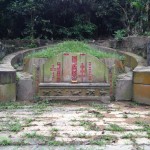I had such an interesting experience today.
I was on my way to purchase my first grown-up furniture piece (at the age of 38, finally– haha!), after many months of searching for That Ultimate Cabinet I Have Been Picturing In My Head That Would Be Perfect For My Space. I was thrilled at the idea of finally having found the closest thing yet, and so I was in a good, relaxed mood as I headed there after school. I’m sure that getting a “free pass” out of my last meeting of the day helped my mood, too! (Thanks, Andrew, if you’re reading this!)
I exited the bus on Outram Road and realized I needed to be on the other side of the street. I found the walkway overpass thing-a-ma-jiggy — pretty standard for Singapore, or any urban city for that matter. But this one was a bit different. It was in two “flights” of steps, with one flight stopping at the edge of what looked like a hill of green space. I wondered, as I was walking up the first flight, what the green space was. I didn’t recall a park being nearby in Tiong Bahru or Outram. I checked my phone: Google Maps showed me just a green, empty space, no names or anything. When I got up to the first flight landing, I was really just going to keep going, but I was still wondering what the space was for. In central Singapore, why wasn’t there a building on this patch?
It wasn’t until I had taken 5 or 6 steps — that is, I was a bit higher — that I noticed the stylized traditional Chinese statues. I think these are called Pi Xiu (mythical dragons?) but I really do not know, so please correct me if you do know. Anyway, I noticed them from that higher step, and thought, wow… those look old. They were hidden, only partically viewable, but I could tell they were covered in moss.
I walked back down the 5 steps, to the landing, which was wedged into the side of the hill. From here I noticed a sign slightly further up the hill that said something to the effect of “State Land: No Trespassing No Dumping.”
No trespassing? But if it’s state land, doesn’t that mean that everyone owns it? I pay taxes. So I thought I’d go have a look…
I walked up some very steep cement block steps that were directed into the hill — maybe another 5? It was clear that they weren’t designed as steps – they were huge, platform-like steps. And then I saw this.
After reading it, I had even more questions. Why, I wondered, wasn’t this part of a national heritage project? Why wasn’t it more well-marked? This site was the burial place of two significant members of Singapore’s history, and here it was, laying inconspicuously on the side of a hill in the Central Business District.
Shortly after I snapped these photos, I heard a rustling on my left. Out of nowhere came something black and furry… and… it was a DOG. A wild dog! He clearly lived here and did NOT want me there. He barked, and I very very quickly ran back to where the overpass footpath steps were. From my vantage point 6 steps up, I looked back to see the dog pacing around the tombstone. This was very clearly his territory, and he was at his guard post.
Well, at least there’s someone (thing?) keeping the spirits at bay for Madams Chua and Wuing, I thought.
And I went on my merry way across the street to the furniture showroom, thinking how wonderful and perplexing and curious it was that I had found this site.
So often, when I tell people I live in Singapore, I get responses such as these:
- “Oh, but it’s not the real Asia.”
- “You mean Asia light?”
- “It’s so sterile it doesn’t feel like it has a culture — it’s so over-developed.”
I could easily take on and refute each of these statements, but I won’t. Instead I’ll say this: Singapore has many of the same aspects of other Asian cultures — and then it has much more of its own. Yes, it is urban, flashy, and in even upmarket in places. But the cultures and histories of this country are deeply embedded into its current identity — which includes both the old AND the new. If you can’t see these, you either haven’t been here long enough, or you’re living in a bubble. These cultures and histories permeate into daily interactions on the MRT, in business, and in regular “hellos” if you pay attention.
I am so glad I was in the kind of headspace that allowed me to be aware of the Chinese lion/dragon-ish (?) statues in my periphery as I climbed the steps over the street. It reminded me of a Singapore past which has greatly influenced the Singapore of today. Sometimes you have to really look for it, this history. But if you look, you will find it, and it won’t necessarily be in a museum.
——
Epilogue
After I purchased my cabinet, I stopped at my local hawker centre and downed a plate of the spiciest Mie Goreng I’ve had in my life (not even joking — I always do tell the aunties that I like it spicy, but this lady wasn’t messing around). I was able to finish it (hurts so good!), thankfully.
Upon returning to my condo complex, a woman who lives in my building held the elevator doors for me, which was kind. She asked me what floor I was on, and then asked, “Have you taken your dinner yet?”
“Oh yes!” I replied, smiling. “And it was excellent.” We both laughed, knowing that this wasn’t really the answer she was expecting. 🙂



